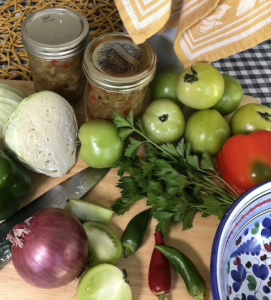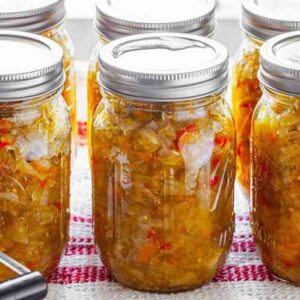Chow-Chow, a favorite Southern condiment

Growing up, many of our family’s evening meals consisted of beans (pinto, butter, or navy) and cornbread with sides of skillet fried potatoes, squash, turnips, collards, or some other kind of greens. One of my father’s favorite condiments with his beans and cornbread was chow-chow. On the other hand, neither my mom nor their picky-eater son cared for it. This suited my father just fine, since that meant he didn’t have to share.
Now as I’ve said before, my mom was a fantastic cook with the ability to make just about any dish taste great. And she did a fair amount of baking as well. The one thing she almost never did was canning, so most of our homemade pickles, jellies, and preserves came from my grandmother’s cellar. This included, of course, my father’s chow-chow.
My grandmother lived on a two hundred fifty plus acre farm in Southeastern Oklahoma on which she raised my mom and her seven siblings. Mom’s two oldest brothers farmed the land and ran a few cattle. For as long as I can remember, Grandmother always had a small vegetable garden in which she raised tomatoes, squash, greens, peppers, cabbage, and some other things. Throughout the year, and especially at the end of the growing season, she would gather up whatever she could and would pickle jars and jars of green beans, tomatoes, her famous bread and butter pickles, and chow-chow, most of which she gave my father each time we visited her. And we visited often.
 For those of you unfamiliar with this delicious condiment, chow-chow is a popular pickled vegetable relish with roots in the American South, from Virginia and the Carolinas, across Kentucky and Tennessee, to Arkansas, Louisiana, and even parts of Texas and Oklahoma. While recipes vary, chow-chow is typically made from green tomatoes, cabbage, onions, peppers and sometimes squash. It can be either sweet or spicy and is traditionally served as an accompaniment to any kind of beans-and-cornbread meal. Today chow-chow (sometimes called “Indian Pickle”) is eaten on everything from meats, fish, and chicken dishes to hamburgers, hot dogs, and barbecue.
For those of you unfamiliar with this delicious condiment, chow-chow is a popular pickled vegetable relish with roots in the American South, from Virginia and the Carolinas, across Kentucky and Tennessee, to Arkansas, Louisiana, and even parts of Texas and Oklahoma. While recipes vary, chow-chow is typically made from green tomatoes, cabbage, onions, peppers and sometimes squash. It can be either sweet or spicy and is traditionally served as an accompaniment to any kind of beans-and-cornbread meal. Today chow-chow (sometimes called “Indian Pickle”) is eaten on everything from meats, fish, and chicken dishes to hamburgers, hot dogs, and barbecue.
Exactly where chow-chow originated is a little vague. One popular theory expressed by the late food historian John Egerton is that it’s thought to have been inspired by 19th century Chinese immigrant laborers who came here to build the railroads. Commonly spiked with citrus and ginger, this Asian relish served as a condiment on a variety of meat dishes, becoming well-liked by people from all walks of life. Egerton also felt that its name came from the Mandarin word “cha,” meaning mixed. Another theory on chow-chows origin is that it was brought to Louisiana by Arcadians who settled there after being expelled from Nova Scotia, leading to the notion that its name comes from the French word “chou” for cabbage.
And the there’s the fact that the British have had a vegetable relish called “piccalilli” going back to at least the 15th century, as referenced in Anne Blencowe’s Receipt Book, published in 1694. This makes it completely plausible that the dish could have come to America with British immigrants. Even today in parts of Northeastern and Midwestern United States piccalillis is still alive and well.
Whichever story you choose to believe, you can be assured that chow-chow's true origin is likely to be some combination of all of these theories.
While chow-chows popularity is primarily restricted to the Southern states, its acceptance is growing throughout the eastern half of North America where there are at least three basic recipe variants.
 Of course, there’s the Southern variety with its combination of tomatoes, bell peppers, sweet onions, and cabbage, as we’ve discussed. Then there’s the Northern style, originating with the Amish communities, which can also contain other vegetables, such as cauliflower, corn, beans, and carrots. And the Amish chow-chow brine is also typically sweeter.
Of course, there’s the Southern variety with its combination of tomatoes, bell peppers, sweet onions, and cabbage, as we’ve discussed. Then there’s the Northern style, originating with the Amish communities, which can also contain other vegetables, such as cauliflower, corn, beans, and carrots. And the Amish chow-chow brine is also typically sweeter.
A lesser-known version can be found in the Maritime provinces of Canada, where chow-chow is made almost entirely of green tomatoes and onions.
Within each of these categories there are regional variations. Case-in-point, Tennessee chow-chow is made with apple cider vinegar rather than the more commonly used white vinegar. Some makers like their chow-chow vinegar forward, while others prefer it more to the sweeter side. Still others like to add a bit of cayenne or diced jalapeño or Fresno chiles for a touch of heat. Truth is, there are as many recipe variants as there are canners. But the one thing they all have in common is deliciousness. In fact, I’ve never tasted a chow-chow I didn’t like (kinda funny how as we mature, so do our taste buds).
 Many state and county fairs throughout the South have chow-chow competitions bringing men and women, young and old, from all around the region to pit their relish against each other in hopes to win the blue ribbon, cash prizes, and most of all, bragging rights for having the best.
Many state and county fairs throughout the South have chow-chow competitions bringing men and women, young and old, from all around the region to pit their relish against each other in hopes to win the blue ribbon, cash prizes, and most of all, bragging rights for having the best.
There’s even an annual Chow Chow Food Festival in Asheville, North Carolina where nationally and locally chefs, farmers, millers, bakers, and Appalachian artisans gather to celebrate through tastings, dinners, workshops and demos. The 2023 festival was held on September 07 to 10 in the heart of downtown Asheville at Pack Square Park. Dates for the 2024 event are yet to be announced.
Today there are more than 35 commercial brands of chow-chow available in supermarkets throughout the Midwestern and Southern states, as well as online. And while I’m certain they’re all very tasty, they just can’t compare to the home canned variety. And since it’s so easy to make, there is almost no reason to purchase the store-bought variety.
 For those of you who love playing around with new recipes, I hope you’ll check out my Grandmother’s Chow-Chow and give it a try. I think you’ll be glad you did. As for me, the beans are done and the cornbread just came out of the oven, so I’m going to go enjoy a big bowl laced with my own personal chow-chow. Mmmmm!
For those of you who love playing around with new recipes, I hope you’ll check out my Grandmother’s Chow-Chow and give it a try. I think you’ll be glad you did. As for me, the beans are done and the cornbread just came out of the oven, so I’m going to go enjoy a big bowl laced with my own personal chow-chow. Mmmmm!


